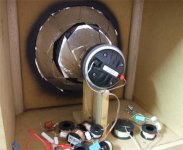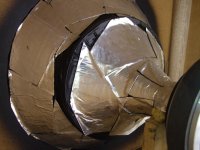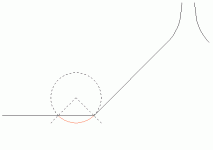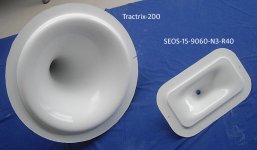So if a speaker were conventionally mounted on a corner baffle back with it's edges adjacent to the walls, naturally this wouldn't be as good a coupling to the corner, but if one wanted the speaker to face forward to get the upper mids from it could this be made to work well enough?
If the speaker is close to the boundary, within a fraction of a wavelength, then it is as good a coupling as you can have. The trick is being near the boundary for all frequencies.
In the end I think you need to do what Allison did: split the band with the woofer near the boundary and bounce null frequency above the crossover point, midrange farther from the boundary with bounce null below the crossover frequency. This applies both to dome and horn speakers although horn directivity should help reduce reflection level. I think it would be practical to use surface damping to eliminate the upper range bounce.
Once you constrain radiation to 1/8th space, does a CD waveguide offer any advantage at all?
David S.
In the end I think you need to do what Allison did: split the band with the woofer near the boundary and bounce null frequency above the crossover point,
Assuming I take a 15" wide piece of board as high as my ceiling and block off the corner in chamfer style. I'm not sure I can see how a driver could create a reflection that would directly reach my listening position, and if one did at perhaps 400-500Hz, a 15" driver would be starting to be directional at that point anyway.
It would. Rarely if ever do I see commercial speaker manufacturers recommend absorption (present company excluded), so I assume that their theories must be constrained by this (usually end user) limitation.I think it would be practical to use surface damping to eliminate the upper range bounce.
In theory, no, I guess.Once you constrain radiation to 1/8th space, does a CD waveguide offer any advantage at all?
David S.
If the speaker is close to the boundary, within a fraction of a wavelength, then it is as good a coupling as you can have. The trick is being near the boundary for all frequencies.
Absolutely. That's the key - acoustic scale.
At low frequencies, the woofer is acoustically small, nearly a point source, and the corner is closer than 1/4λ. The corner acts like a large waveguide and sets the pattern from the Schroeder frequency up.
But as frequency rises, it becomes less practical to position the sound source this close to the boundary.
Once you constrain radiation to 1/8th space, does a CD waveguide offer any advantage at all?
I think at high frequencies, yes. The tweeter cannot be acoustically close to the boundaries, so I think having a directional tweeter is important, keeping the beamwidth within the walls. And as we were saying on another thread, horn loading has a lot of other useful benefits in addition to directivity.
The midrange is sort of the transition band. It is nearly at the same acoustical scale, so at the low end of its passband, the sound source may be within 1/4λ but at the high end, probably not. It goes from being acoustically small to acoustically large, with all the path length issues and directivity changes that result.
My conclusion is that horn loading the midrange helps as sort of an "interface". At the low end, the mouth couples with the corner, making the boundaries act sort of like extensions for the horn. At the high end, the flare profile sets the pattern, much like the tweeter.
The midrange is sort of the transition band. It is nearly at the same acoustical scale, so at the low end of its passband, the sound source may be within 1/4λ but at the high end, probably not. It goes from being acoustically small to acoustically large, with all the path length issues and directivity changes that result.
Which is where a Unity style waveguide may shine: My Unity Horn Speakers
Sheldon
The better link would have been the whole story,
3D3A Lab at Princeton University
But I guess thats typical.
This is an old model Nathan.
I was impressed by the quality of the Genelec's measured response in the Princeton study. I have listened to the Behringer design, but was unimpressed by the quality.
This evening I was at Costco, and noticed a well-designed JBL speaker with a waveguide, and decided to spend a whopping $50 on it.
Here's my review, with polar measurements:
Audio Psychosis • View topic - Fifty Dollar Speaker Review
The response graph elicited an out-loud "holy s***" from me.I was impressed by the quality of the Genelec's measured response in the Princeton study. I have listened to the Behringer design, but was unimpressed by the quality.
This evening I was at Costco, and noticed a well-designed JBL speaker with a waveguide, and decided to spend a whopping $50 on it.
Here's my review, with polar measurements:
Audio Psychosis • View topic - Fifty Dollar Speaker Review
What model are they?
I applaud you for your motivation, Patrick.
As I move closer to building corner speakers I try to recall what evidence I have read contrary to the idea of using corners and IIRC there's little to suggest that we shouldn't. As long as we don't wrongly try to shove freestanding designs into a corner.
As I move closer to building corner speakers I try to recall what evidence I have read contrary to the idea of using corners and IIRC there's little to suggest that we shouldn't. As long as we don't wrongly try to shove freestanding designs into a corner.
The response graph elicited an out-loud "holy s***" from me.
What model are they?
how did i leave that out???
They're JBL Control Now, fifty bones at Costco. Call ahead, I couldn't find another pair in my whole state.
I want to shorten my waveguides to reduce GD between the drivers, but I also want to radius the mouths which will make them longer all up. They are currently 15" in diameter at the baffle and meet at a sharp 45 degree angle. I have three options which I'm having trouble deciding on.
1. shorten the current mouths to where they are 10" in diameter, then radius them into the baffle. This helps shorten the WGs by over an inch but now they are smaller in diameter.
2. Lay a segment of a torus on the baffle around the current mouth, being the easiest way to terminate the mouth but this helps none with the GD issue.
3. Radius the current mouth as well as push it all forward on the baffle. This will protrude in front of the baffle quite a bit.
1. shorten the current mouths to where they are 10" in diameter, then radius them into the baffle. This helps shorten the WGs by over an inch but now they are smaller in diameter.
2. Lay a segment of a torus on the baffle around the current mouth, being the easiest way to terminate the mouth but this helps none with the GD issue.
3. Radius the current mouth as well as push it all forward on the baffle. This will protrude in front of the baffle quite a bit.
Allen: Look at the reduction in distance (translating to reduction in Group Delay) in the region of overlap around the crossover frequency.
Now convert that to the change in the linear shift of phase (group delay) over this same region. I supsect the difference will be trivial.
Now convert that to the change in the linear shift of phase (group delay) over this same region. I supsect the difference will be trivial.
My crossover is at 900Hz and is still in play at 1800Hz where a wavelength is 7.5" and my driver offset is 6".
With putting the woofers behind the baffle, I could halve this but I stand to lose waveguide size in the process. I simply do not know which is more of an issue.
With putting the woofers behind the baffle, I could halve this but I stand to lose waveguide size in the process. I simply do not know which is more of an issue.
My crossover is at 900Hz and is still in play at 1800Hz where a wavelength is 7.5" and my driver offset is 6".
With putting the woofers behind the baffle, I could halve this but I stand to lose waveguide size in the process. I simply do not know which is more of an issue.
I would worry more about losing WG size, since that is controlling the dispersion at the lower freqs (and the loading to a certain extent).
BTW the 1800 Hz number is misleading, since it will be at least 6 dB down (or so). When one "element" is 6 dB down re: the other, then the actual value of the phase may be playing an insignificant role in how the amplitudes add.
I am curious, just how much modification are you performing relative to the Geddes-implementation? Are these minor tweaks or major mods?
My option No.1 above with the smaller WG would be similar to the size of a summa WG so it must be acceptable, but even Dr Geddes says that it can be better. It's a tradeoff somehow.I would worry more about losing WG size, since that is controlling the dispersion at the lower freqs (and the loading to a certain extent).
What specifically do you mean? I have the Dayton 8" waveguides (smooth long transition). I have bonded these to good metal 90 degree 15" lampshades which I have joined at the point where they are tangent to the Daytons. I then damped them with roofing bitumen.I am curious, just how much modification are you performing relative to the Geddes-implementation? Are these minor tweaks or major mods?
Attachments
I've tried to research this before, but I have found a bank of opinion that believes that this amount of group delay can be safely looked upon as nothing more than the relative phase (wrapped) of the drivers, which I'm pleased to find out.
Not that it's any fun trying to work with such a separation, but I have an adequate solution in effect so I'm off the hook at least.
With regards to the rounding, I would prefer option 2. I may get some flexible hose of an adequate diameter (4 inch diameter fits well on my current baffle without encroaching too far on the woofer). I'd cut it like in the diagram below. I figure that the outer edge is secondary but I could fill it in if I find it necessary.
Not that it's any fun trying to work with such a separation, but I have an adequate solution in effect so I'm off the hook at least.
With regards to the rounding, I would prefer option 2. I may get some flexible hose of an adequate diameter (4 inch diameter fits well on my current baffle without encroaching too far on the woofer). I'd cut it like in the diagram below. I figure that the outer edge is secondary but I could fill it in if I find it necessary.
Attachments
SEOS 15" waveguide and popular "classic" horn Tractrix-200. Prototypes.
pretty
pretty
Bill, did you find another QSC HPR-152 (re: your post on techtalk classifieds)?
- Home
- Loudspeakers
- Multi-Way
- Geddes on Waveguides



